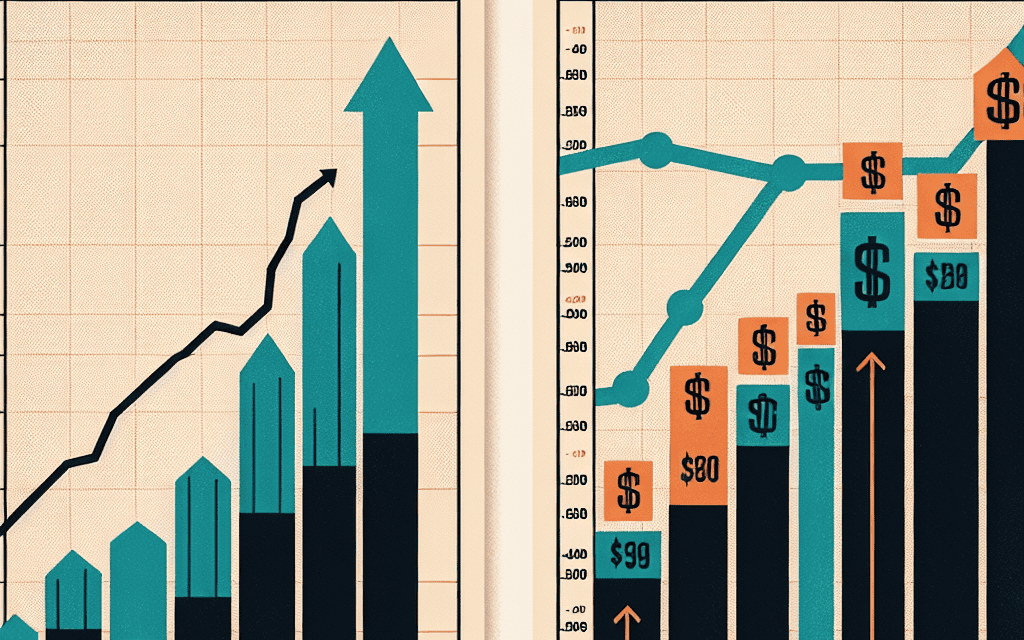“Power Up Your Portfolio: Top 2 High-Yield Utility Stocks Under $200 to Buy Now!”
Introduction
Investors seeking stable income and potential growth often turn to utility stocks, known for their reliable dividends and resilience in various economic climates. As of now, two high-yield utility stocks under $200 stand out as compelling options for those looking to bolster their portfolios. These companies not only offer attractive dividend yields but also possess strong fundamentals and strategic growth initiatives that position them well for the future. By focusing on these top utility stocks, investors can benefit from steady income streams while potentially capitalizing on long-term capital appreciation.
Analyzing Dividend Growth Potential in High-Yield Utility Stocks
In the realm of investment, utility stocks have long been favored for their stability and consistent dividend payouts. As investors seek reliable income streams, high-yield utility stocks become particularly attractive. Among these, two standout options under $200 merit attention for their dividend growth potential: NextEra Energy Partners, LP (NEP) and Dominion Energy, Inc. (D). Both companies not only offer substantial yields but also demonstrate promising prospects for dividend growth, making them compelling choices for income-focused investors.
NextEra Energy Partners, LP, a leader in the renewable energy sector, has consistently delivered robust financial performance. The company’s strategic focus on clean energy assets, including wind and solar projects, positions it well for future growth. As the global shift towards sustainable energy accelerates, NEP is poised to benefit from increased demand for renewable energy sources. This transition is supported by favorable government policies and growing environmental awareness, which are likely to drive further investments in clean energy infrastructure. Consequently, NEP’s ability to generate stable cash flows from its diversified portfolio of assets underpins its capacity to sustain and potentially increase its dividend payouts over time.
Moreover, NEP’s commitment to expanding its asset base through strategic acquisitions and partnerships enhances its growth trajectory. By leveraging its relationship with its parent company, NextEra Energy, Inc., NEP gains access to a pipeline of high-quality projects, ensuring a steady stream of revenue. This strategic alignment not only bolsters NEP’s financial stability but also reinforces its dividend growth potential. As a result, investors seeking exposure to the renewable energy sector with a focus on dividend income may find NEP an appealing choice.
Transitioning to Dominion Energy, Inc., this company stands out as a prominent player in the utility sector with a diversified portfolio that spans electric and natural gas operations. Dominion’s strategic initiatives, including its focus on renewable energy and grid modernization, align with the industry’s evolving landscape. The company’s commitment to reducing carbon emissions and investing in clean energy projects underscores its dedication to sustainable growth. This forward-thinking approach not only enhances Dominion’s environmental credentials but also positions it to capitalize on the growing demand for cleaner energy solutions.
Dominion’s financial strength is further evidenced by its consistent dividend payments and a history of dividend increases. The company’s disciplined capital allocation strategy, coupled with its focus on operational efficiency, supports its ability to generate stable cash flows. This financial resilience provides a solid foundation for sustaining and potentially growing its dividends, making Dominion an attractive option for income-oriented investors.
In conclusion, both NextEra Energy Partners, LP and Dominion Energy, Inc. offer compelling opportunities for investors seeking high-yield utility stocks with dividend growth potential. NEP’s focus on renewable energy and strategic partnerships positions it well for future growth, while Dominion’s diversified operations and commitment to sustainability enhance its long-term prospects. As the utility sector continues to evolve, driven by the global transition to cleaner energy sources, these companies are well-positioned to deliver reliable income streams to investors. By carefully analyzing their financial performance, strategic initiatives, and market positioning, investors can make informed decisions to capitalize on the dividend growth potential of these high-yield utility stocks.
Comparing Valuation Metrics of Top Utility Stocks Under $200
In the ever-evolving landscape of investment opportunities, utility stocks have long been a staple for investors seeking stability and reliable income. Among these, high-yield utility stocks stand out, offering attractive dividends while maintaining a relatively low-risk profile. As we delve into the realm of utility stocks priced under $200, two companies emerge as particularly compelling options: NextEra Energy, Inc. (NEE) and Duke Energy Corporation (DUK). By examining their valuation metrics, we can gain a clearer understanding of why these stocks are worthy of consideration for investors looking to bolster their portfolios with high-yield options.
NextEra Energy, Inc., a leader in the renewable energy sector, has consistently demonstrated robust financial performance. Its price-to-earnings (P/E) ratio, a key valuation metric, provides insight into how the market values the company’s earnings. As of the latest data, NextEra Energy’s P/E ratio hovers around 25, which, while slightly above the industry average, reflects investor confidence in its growth prospects. This premium valuation is justified by the company’s strategic investments in renewable energy projects, positioning it as a frontrunner in the transition to cleaner energy sources. Furthermore, NextEra’s dividend yield, currently at approximately 2.2%, offers a steady income stream, appealing to income-focused investors.
Transitioning to Duke Energy Corporation, we observe a different yet equally compelling investment narrative. Duke Energy, with its extensive portfolio of regulated utilities, provides a more traditional approach to utility investment. Its P/E ratio, currently around 18, suggests a more conservative valuation compared to NextEra Energy. This lower P/E ratio may appeal to value-oriented investors who prioritize stability over growth. Duke Energy’s dividend yield, an impressive 4.1%, is notably higher than that of NextEra, making it an attractive choice for those seeking higher immediate income. This substantial yield is supported by Duke’s consistent cash flow from its regulated operations, ensuring the sustainability of its dividend payouts.
When comparing these two utility giants, it is essential to consider their respective growth trajectories and risk profiles. NextEra Energy’s focus on renewable energy projects positions it for long-term growth, driven by the global shift towards sustainable energy solutions. However, this growth potential comes with inherent risks associated with the volatility of renewable energy markets and regulatory changes. On the other hand, Duke Energy’s emphasis on regulated utilities offers a more predictable revenue stream, albeit with limited growth prospects compared to its renewable-focused counterpart.
In conclusion, both NextEra Energy and Duke Energy present compelling investment opportunities for those seeking high-yield utility stocks under $200. NextEra’s premium valuation and growth potential make it an attractive option for investors with a higher risk tolerance and a focus on long-term capital appreciation. Conversely, Duke Energy’s conservative valuation and higher dividend yield cater to income-focused investors who prioritize stability and immediate returns. By carefully considering these valuation metrics and aligning them with individual investment goals, investors can make informed decisions that enhance their portfolios with reliable, high-yield utility stocks. As the energy sector continues to evolve, these two companies stand poised to deliver value to shareholders, each in their unique way.
Exploring Market Trends Impacting Utility Stock Performance
In recent years, the utility sector has garnered significant attention from investors seeking stable returns and reliable income streams. As the global economy continues to navigate through periods of uncertainty, utility stocks have emerged as a beacon of stability, offering consistent dividends and a hedge against market volatility. This trend is particularly evident in high-yield utility stocks, which have become increasingly attractive to income-focused investors. Among these, two standout options under $200 have captured the interest of market participants, driven by their robust performance and promising growth prospects.
The first stock to consider is NextEra Energy, Inc. (NEE), a leader in the renewable energy space. As the world shifts towards sustainable energy solutions, NextEra Energy has positioned itself at the forefront of this transition. The company’s strategic investments in wind and solar projects have not only bolstered its revenue streams but also enhanced its reputation as a forward-thinking utility provider. Furthermore, NextEra Energy’s commitment to expanding its clean energy portfolio aligns with global efforts to combat climate change, making it a compelling choice for environmentally conscious investors. The stock’s impressive dividend yield, coupled with its potential for capital appreciation, underscores its appeal as a high-yield investment opportunity.
Transitioning to the second notable utility stock, Dominion Energy, Inc. (D), offers a unique blend of traditional utility services and innovative energy solutions. Dominion Energy’s diversified operations, which include electric and natural gas utilities, provide a stable foundation for consistent earnings. Additionally, the company’s strategic focus on renewable energy projects and infrastructure development positions it well for future growth. Dominion Energy’s recent initiatives to modernize its grid and expand its renewable energy capacity reflect its commitment to sustainability and long-term value creation. These efforts are expected to drive earnings growth and support the company’s ability to maintain its attractive dividend yield, making it a top choice for investors seeking high-yield utility stocks.
As we delve deeper into the factors influencing utility stock performance, it is essential to consider the broader market trends shaping the sector. One significant trend is the increasing demand for clean energy solutions, driven by regulatory pressures and consumer preferences. Governments worldwide are implementing policies to reduce carbon emissions, prompting utility companies to invest heavily in renewable energy projects. This shift not only enhances the growth prospects of companies like NextEra Energy and Dominion Energy but also underscores the importance of sustainability in the utility sector.
Moreover, the ongoing technological advancements in energy storage and grid management are transforming the utility landscape. Companies that can effectively integrate these technologies into their operations are likely to gain a competitive edge, further boosting their stock performance. Investors should also be mindful of interest rate fluctuations, as they can impact utility stocks’ attractiveness relative to other income-generating assets. In a low-interest-rate environment, high-yield utility stocks become particularly appealing, offering a reliable income stream with the potential for capital appreciation.
In conclusion, the utility sector presents a compelling investment opportunity for those seeking stability and income in an uncertain market environment. NextEra Energy and Dominion Energy stand out as top high-yield utility stocks under $200, driven by their strategic focus on renewable energy and infrastructure development. As market trends continue to evolve, these companies are well-positioned to capitalize on the growing demand for clean energy solutions, making them attractive options for investors looking to enhance their portfolios with reliable, high-yield investments.
Evaluating Risk Factors in High-Yield Utility Investments

When considering high-yield utility stocks, investors often seek a balance between attractive dividend returns and manageable risk. Utility companies, known for their stable cash flows and essential services, are typically seen as safe havens in volatile markets. However, even within this sector, it’s crucial to evaluate the risk factors that could impact the sustainability of dividends and overall investment returns. Two high-yield utility stocks under $200 that merit attention are NextEra Energy Partners (NEP) and Dominion Energy (D). Both offer compelling dividend yields, but understanding the associated risks is essential for informed investment decisions.
NextEra Energy Partners, a leader in renewable energy, has garnered attention for its robust dividend yield and growth potential. The company focuses on clean energy projects, including wind and solar, which align with global trends toward sustainable energy solutions. However, investing in NEP requires careful consideration of several risk factors. Firstly, the renewable energy sector is heavily influenced by government policies and subsidies. Changes in legislation or reductions in subsidies could impact NEP’s profitability and, consequently, its ability to maintain or grow dividends. Additionally, the capital-intensive nature of renewable projects means that NEP is reliant on continuous access to financing. Any disruptions in capital markets or increases in interest rates could affect the company’s expansion plans and financial health.
On the other hand, Dominion Energy, a more traditional utility company, offers a different risk profile. Dominion’s operations span electricity generation, transmission, and natural gas distribution, providing a diversified revenue stream. The company’s commitment to transitioning towards cleaner energy sources, such as natural gas and renewables, positions it well for future growth. However, Dominion faces its own set of challenges. Regulatory risks are significant, as utility rates and operations are subject to government oversight. Any adverse regulatory changes could impact Dominion’s revenue and profitability. Furthermore, the company’s substantial debt load, a common trait among utility companies, necessitates careful management to ensure that interest obligations do not hinder dividend payments.
Despite these risks, both NextEra Energy Partners and Dominion Energy present opportunities for investors seeking high-yield utility stocks. NEP’s focus on renewable energy aligns with long-term industry trends, potentially offering growth alongside income. Meanwhile, Dominion’s diversified operations and strategic shift towards cleaner energy provide a stable foundation for dividend sustainability. To mitigate risks, investors should consider diversifying their portfolios across multiple utility stocks and sectors. This approach can help balance the specific risks associated with each company while still capitalizing on the overall stability and income potential of the utility sector.
In conclusion, while high-yield utility stocks like NextEra Energy Partners and Dominion Energy offer attractive dividends, they are not without risks. Understanding the unique challenges each company faces, from regulatory changes to capital requirements, is crucial for making informed investment decisions. By carefully evaluating these risk factors and considering diversification strategies, investors can better position themselves to benefit from the income and stability that utility stocks traditionally provide. As always, thorough research and a clear understanding of one’s risk tolerance are essential components of a successful investment strategy in the utility sector.
Understanding the Role of Utility Stocks in a Diversified Portfolio
In the realm of investment, utility stocks have long been regarded as a cornerstone for building a diversified portfolio. These stocks, representing companies that provide essential services such as electricity, water, and natural gas, are often characterized by their stability and consistent dividend payouts. As investors seek to balance risk and reward, utility stocks offer a reliable income stream, making them an attractive option for those looking to enhance their portfolio’s resilience. In this context, identifying high-yield utility stocks that are both affordable and promising becomes crucial. Among the myriad of options available, two utility stocks stand out for their potential to deliver robust returns while remaining under the $200 price point.
First on the list is NextEra Energy, Inc. (NEE), a leader in the renewable energy sector. As the world increasingly shifts towards sustainable energy solutions, NextEra Energy has positioned itself at the forefront of this transition. The company’s commitment to expanding its renewable energy portfolio, particularly in wind and solar power, has not only bolstered its growth prospects but also ensured a steady flow of dividends to its shareholders. With a strong track record of dividend increases, NextEra Energy offers a compelling case for investors seeking both growth and income. Moreover, its strategic investments in clean energy infrastructure align with global trends towards decarbonization, providing a long-term growth trajectory that is both sustainable and lucrative.
Transitioning to another noteworthy contender, Duke Energy Corporation (DUK) emerges as a formidable player in the utility sector. Known for its extensive network of electric and gas utilities, Duke Energy has consistently delivered reliable service to millions of customers across the United States. The company’s focus on modernizing its grid infrastructure and expanding its renewable energy capacity underscores its commitment to innovation and sustainability. This forward-thinking approach not only enhances operational efficiency but also positions Duke Energy as a key contributor to the evolving energy landscape. Furthermore, Duke Energy’s robust dividend yield, coupled with its strategic initiatives to reduce carbon emissions, makes it an attractive option for investors prioritizing both income and environmental responsibility.
Incorporating these high-yield utility stocks into a diversified portfolio can offer several advantages. Firstly, the inherent stability of utility companies, driven by the essential nature of their services, provides a buffer against market volatility. This stability is further reinforced by the regulated nature of the utility industry, which ensures predictable revenue streams and, consequently, consistent dividend payouts. Additionally, the growing emphasis on renewable energy presents significant growth opportunities for companies like NextEra Energy and Duke Energy, which are actively investing in sustainable energy solutions. By capitalizing on these trends, investors can potentially benefit from both capital appreciation and dividend income.
In conclusion, while the stock market is often characterized by its unpredictability, utility stocks offer a semblance of stability and reliability. NextEra Energy and Duke Energy, with their strong dividend yields and strategic focus on renewable energy, represent compelling investment opportunities for those seeking to enhance their portfolio’s resilience. By understanding the role of utility stocks in a diversified portfolio, investors can make informed decisions that align with their financial goals and risk tolerance. As the global energy landscape continues to evolve, these high-yield utility stocks stand poised to deliver both income and growth, making them worthy additions to any well-rounded investment strategy.
Assessing the Financial Health of Leading Utility Companies
In the ever-evolving landscape of investment opportunities, utility stocks have long been regarded as a stable and reliable choice for investors seeking consistent returns. As the backbone of essential services such as electricity, water, and natural gas, utility companies offer a unique blend of stability and income generation. Among the myriad of options available, two high-yield utility stocks under $200 have emerged as particularly attractive investments. To make informed decisions, it is crucial to assess the financial health of these leading utility companies, ensuring they possess the resilience and growth potential necessary to thrive in the current economic climate.
First and foremost, the financial health of a utility company can be gauged by examining its balance sheet. A strong balance sheet typically features a healthy mix of assets and liabilities, with a manageable level of debt. This is particularly important for utility companies, as they often require significant capital expenditures to maintain and expand their infrastructure. A company with a solid balance sheet is better positioned to weather economic downturns and capitalize on growth opportunities. Additionally, a robust balance sheet can provide the flexibility needed to invest in new technologies and adapt to changing regulatory environments.
Another critical aspect of financial health is cash flow generation. Utility companies with strong cash flow are better equipped to meet their operational needs, service their debt, and pay dividends to shareholders. Consistent cash flow is indicative of a company’s ability to generate revenue from its core operations, which is essential for long-term sustainability. Investors should pay close attention to a company’s cash flow statements, as they provide valuable insights into its operational efficiency and financial stability.
Moreover, profitability is a key indicator of a utility company’s financial health. Profit margins, return on equity, and return on assets are essential metrics to consider when evaluating a company’s profitability. A utility company with strong profitability is more likely to generate higher returns for its shareholders, making it an attractive investment option. Furthermore, profitability can serve as a buffer against economic uncertainties, allowing the company to maintain its dividend payments even during challenging times.
In addition to these financial metrics, it is important to consider the regulatory environment in which a utility company operates. Regulatory frameworks can significantly impact a company’s financial performance, as they dictate the rates that utilities can charge their customers and the level of investment required to comply with environmental standards. Companies operating in favorable regulatory environments are more likely to experience stable revenue streams and reduced operational risks.
Finally, the growth potential of a utility company is a crucial factor to consider when assessing its financial health. Companies that are well-positioned to capitalize on emerging trends, such as the transition to renewable energy sources and the increasing demand for smart grid technologies, are likely to experience sustained growth in the coming years. By investing in companies with strong growth prospects, investors can benefit from both capital appreciation and dividend income.
In conclusion, assessing the financial health of leading utility companies involves a comprehensive analysis of their balance sheets, cash flow generation, profitability, regulatory environment, and growth potential. By focusing on these key factors, investors can identify high-yield utility stocks under $200 that offer both stability and growth opportunities. As the demand for essential services continues to rise, these well-positioned utility companies are poised to deliver consistent returns, making them an attractive addition to any investment portfolio.
Identifying Key Drivers of Utility Stock Price Movements
When considering investments in utility stocks, particularly those offering high yields, it is crucial to understand the key drivers that influence their price movements. Utility stocks are often favored by investors seeking stable returns and income through dividends, given their essential role in providing electricity, water, and natural gas. However, like any investment, their prices are subject to various factors that can impact their performance. By identifying these drivers, investors can make more informed decisions, especially when considering high-yield utility stocks under $200.
One of the primary drivers of utility stock prices is interest rates. Utilities are capital-intensive businesses that rely heavily on debt to finance their operations and infrastructure projects. Consequently, changes in interest rates can significantly affect their cost of borrowing. When interest rates rise, the cost of debt increases, potentially squeezing profit margins and leading to lower stock prices. Conversely, when interest rates fall, utilities can benefit from cheaper borrowing costs, which can enhance profitability and support higher stock valuations. Therefore, monitoring interest rate trends is essential for investors in utility stocks.
In addition to interest rates, regulatory environments play a pivotal role in shaping utility stock prices. Utilities are subject to extensive regulation, as they operate in industries that are critical to public welfare. Regulatory bodies determine the rates that utilities can charge customers, which directly impacts their revenue and profitability. Favorable regulatory decisions, such as rate increases or supportive policies for infrastructure investments, can boost utility stock prices. On the other hand, stringent regulations or unfavorable rate decisions can pose challenges, potentially leading to declines in stock valuations. Thus, understanding the regulatory landscape is vital for assessing the prospects of utility stocks.
Another significant factor influencing utility stock prices is the demand for energy and resources. Economic growth, population trends, and technological advancements can all affect the demand for utilities. For instance, during periods of economic expansion, increased industrial activity and consumer spending can drive higher energy consumption, benefiting utility companies. Similarly, population growth can lead to greater demand for water and electricity. However, technological advancements, such as energy efficiency improvements and the rise of renewable energy sources, can alter demand dynamics. Utilities that adapt to these changes by investing in renewable energy and modernizing their infrastructure may be better positioned to thrive in the evolving market landscape.
Furthermore, environmental considerations are increasingly impacting utility stock prices. As concerns about climate change and sustainability grow, utilities are under pressure to reduce their carbon footprint and transition to cleaner energy sources. Companies that proactively address these challenges by investing in renewable energy and reducing emissions may be viewed more favorably by investors, potentially leading to higher stock prices. Conversely, utilities that lag in adopting sustainable practices may face reputational risks and regulatory penalties, which could negatively affect their stock performance.
In conclusion, understanding the key drivers of utility stock price movements is essential for investors seeking high-yield opportunities under $200. Interest rates, regulatory environments, demand dynamics, and environmental considerations all play critical roles in shaping the performance of utility stocks. By carefully analyzing these factors, investors can make informed decisions and potentially capitalize on the stability and income-generating potential that utility stocks offer. As the market continues to evolve, staying informed about these drivers will be crucial for navigating the complexities of utility stock investments.
Q&A
1. **Question:** What is a high-yield utility stock under $200 known for its strong dividend history?
**Answer:** Duke Energy Corporation (DUK) is known for its strong dividend history and offers a high yield.
2. **Question:** Which utility stock under $200 has a significant presence in renewable energy?
**Answer:** NextEra Energy, Inc. (NEE) has a significant presence in renewable energy and is a top utility stock under $200.
3. **Question:** What is a key factor that makes Duke Energy Corporation a reliable investment?
**Answer:** Duke Energy Corporation’s stable cash flow and regulated utility operations make it a reliable investment.
4. **Question:** Why is NextEra Energy considered a growth-oriented utility stock?
**Answer:** NextEra Energy is considered growth-oriented due to its investments in renewable energy projects and innovative energy solutions.
5. **Question:** What is the dividend yield range typically offered by Duke Energy?
**Answer:** Duke Energy typically offers a dividend yield in the range of 3.5% to 4.5%.
6. **Question:** How does NextEra Energy’s focus on clean energy impact its stock appeal?
**Answer:** NextEra Energy’s focus on clean energy enhances its stock appeal by aligning with global sustainability trends and future energy demands.
7. **Question:** What is a potential risk associated with investing in utility stocks like Duke Energy and NextEra Energy?
**Answer:** A potential risk is regulatory changes that could impact utility rates and profitability.
Conclusion
Two high-yield utility stocks under $200 that are worth considering are NextEra Energy, Inc. (NEE) and Duke Energy Corporation (DUK). NextEra Energy is a leader in renewable energy, offering a strong dividend yield and growth potential due to its investments in wind and solar projects. Duke Energy provides a stable dividend and has a robust infrastructure, with a focus on transitioning to cleaner energy sources. Both companies offer attractive yields and are well-positioned to benefit from the ongoing shift towards sustainable energy, making them compelling options for investors seeking income and growth in the utility sector.





